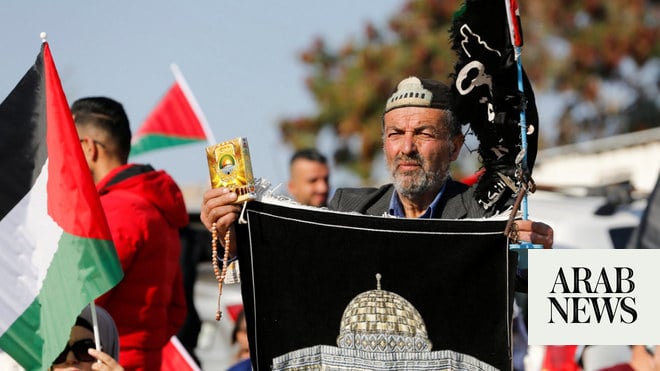
To build a school from tires is more sensible than it sounds at first, given that it is just east of Jerusalem, baking in the summer and freezing in the winter, and the rubber is an excellent insulator.
A mere 2,200 tires, mud and falafel oil were needed to build the school in the Palestinian Bedouin community of Khan Al-Ahmar that has survived now for eight years and serves around 170 children. I visited shortly after it was built with the first of many delegations of British Members of Parliament. At the time it seemed innovative, but also even then doomed. Looking back, eight years actually seems like a success given that it could have been demolished long ago.
One wondered whether it was wise for an Italian NGO to spend funds on something that the Israeli army would shortly be bulldozing. On a subsequent visit with more MPs, we saw the remains of some swings in a new school playground. According to an Israeli army officer, the swings represented a permanent construction above 10 centimeters so had to be confiscated. Perhaps some of the settler children nearby would be using them.
Last week, the Bedouin were back in court, the fate of their community resting in the hands of the occupying power. The court has delayed a decision for a week, but it does seem inevitable what will happen: The school and 46 homes will be destroyed.
In the topsy-turvy world of the regime of the Israeli occupation, which the US State Department no longer thinks exists, schools are targets for demolition. Sorry, that is Palestinian schools, not Israeli settler schools. At present, 44 Palestinian schools in the West Bank are at risk of full or partial demolition.
Khan Al-Ahmar, meanwhile, is one of at least 46 Palestinian communities in the central West Bank under threat of demolition and forcible transfer. These Palestinians are Bedouin, or more precisely herding communities, who are already refugees having fled in fear in 1950 from the Negev in what is now southern Israel. Although under the care of the United Nations, the world body is just a spectator to this evolving crime.
The West Bank Bedouin community of Khan Al-Ahmar that is threatened by Israel bulldozers is vital to Palestine.
Chris Doyle
Israel wants to force the Bedouin on again, 70 years after the Nakba, as the 70 percent of the Palestinian population who are refugees mark yet another grim anniversary. This time, Israel has earmarked a “township” — yes, that is what the Israeli authorities call it, for them near Jericho, but it is not ready. For the Bedouins of Khan Al-Ahmar, the Israeli authorities will transfer them to a site called Jabal West, right next to the Jerusalem municipal garbage dump; unsanitary and barely fit for life.
One member of the Knesset called a Palestinian building in Area C, the 60 percent of the West Bank Israel has full control over, “construction terror.” Yes, the shanty buildings of corrugated iron and concrete, the school built out of mud and tires, are terrorism. As many as 400,000 Palestinians live in Area C but, no matter what their needs, the Israeli authorities barely ever allow them construction permits. Israeli settlements are illegal under international law, but even the illegal settlement outposts crop up and expand without the bulldozers coming to pay a visit.
The Bedouins of this community and others have sought justice from the highest court of the occupying power, unsurprisingly in vain. Judge Noam Sohlberg, a member of Israel’s Supreme Court, who heads the panel of three, is himself a settler, so hardly a neutral party. The harsh reality is that the court process is just a way of drawing out the torture, delaying the inevitable.
The awkward part of it for Israel is that forcible transfer is a war crime. But so are the Israeli settlements that will be gobbling up the land of these communities. War crimes do not seem to disturb the equilibrium of Israel’s most far-right government ever — just ask the people of Gaza, who have been treated to live ammunition from Israeli snipers as a form of crowd control.
Khan Al-Ahmar matters for all sorts of reasons — primarily for the future of the Bedouin and their fate. The school is the only one in the area, the alternative being a 15-kilometer walk away. But it is also vital for any chance of a viable independent Palestinian state. If the giant settlement project of E1 planned for this area proceeds, it will split the West Bank in two. The best Palestinians could hope for would be a series of semi-autonomous zones, not a contiguous state. It also matters because, for once, the international community has taken a stand. Ministers from all over the world have made their way to this school, including more than 40 British MPs.
Israel will carry this out, but how will the EU states in particular react? Their heads of mission in Jerusalem have visited the site on many occasions. The EU has financially supported 21 schools slated for destruction in Area C, so they have a stake in their survival. Yet, once again, Israel brushes off any demands for compensation when it demolishes EU-funded projects. The contempt for European powers will be marked, but will there be any reaction? Don’t bank on it.
Chris Doyle is director of the London-based Council for Arab-British Understanding (CAABU). He has worked with the council since 1993 after graduating with a first class honors degree in Arabic and Islamic Studies at Exeter University. He has organized and accompanied numerous British parliamentary delegations to Arab countries. Twitter: @Doylech












